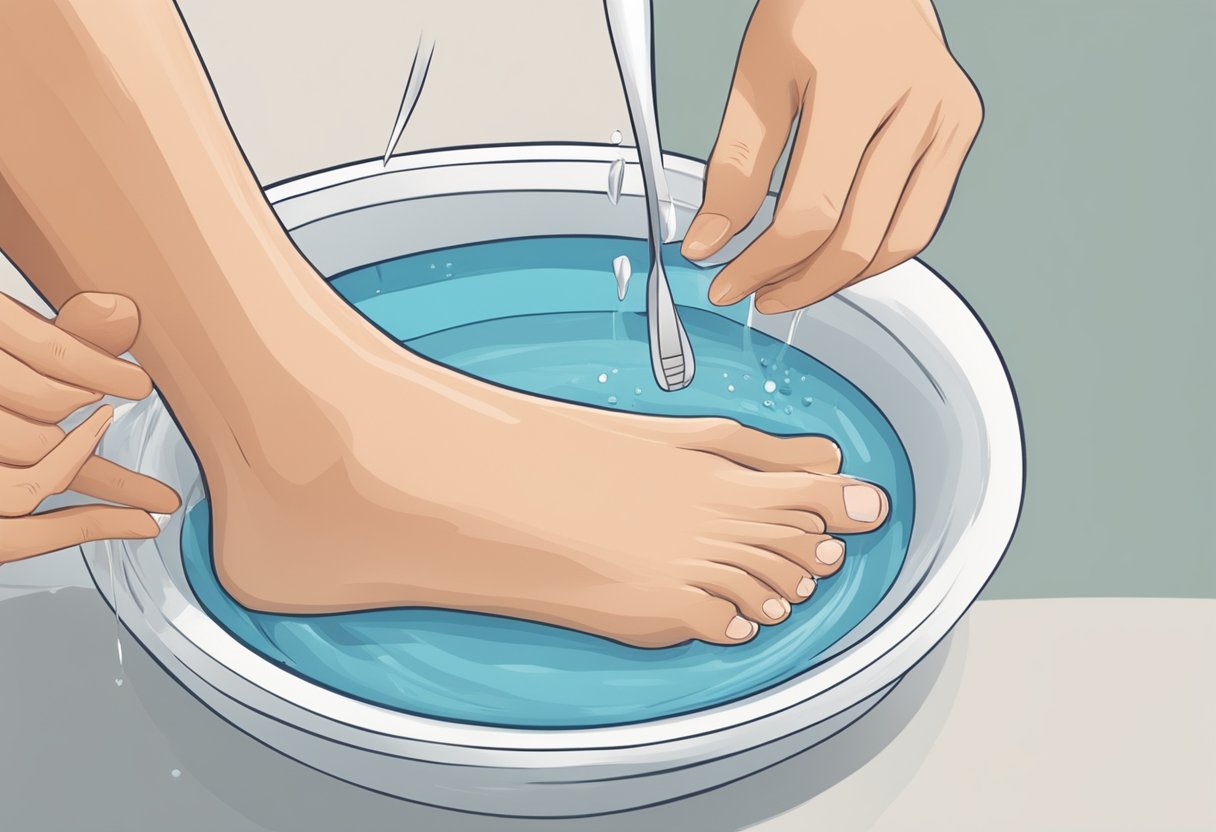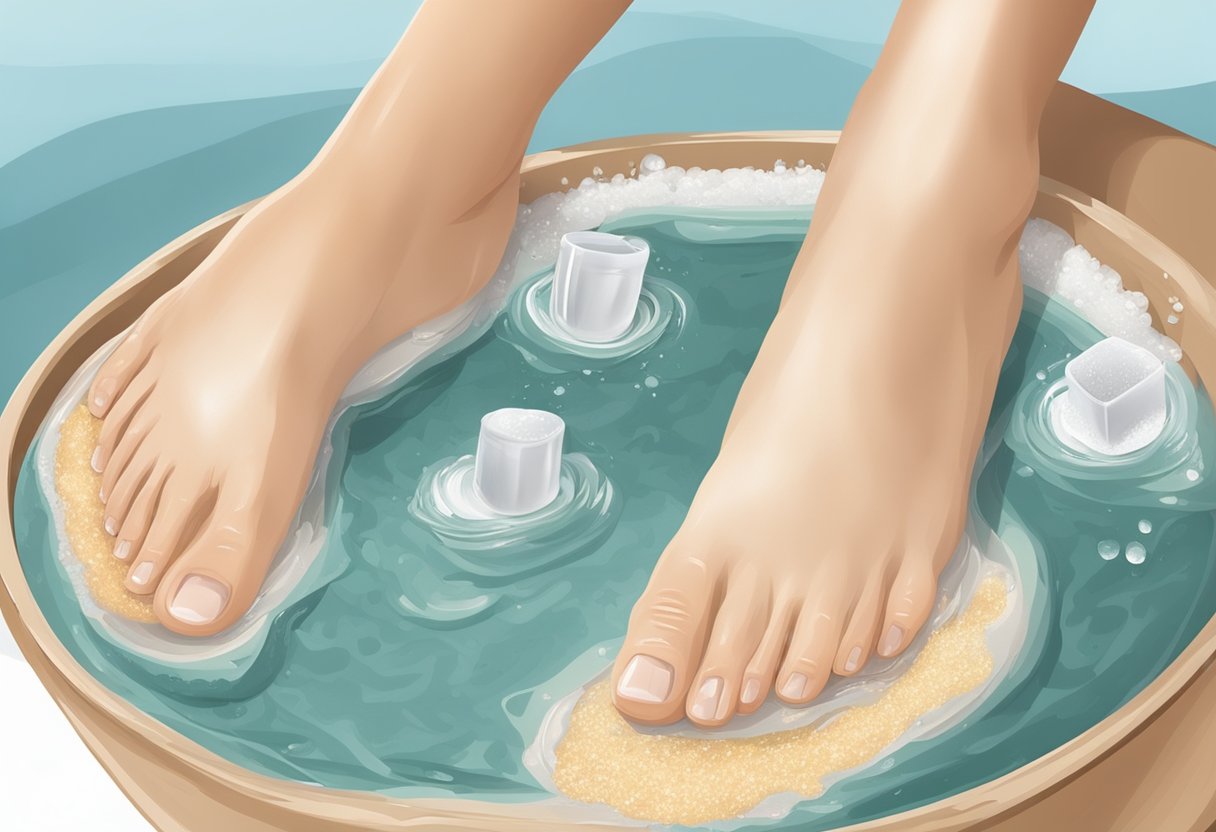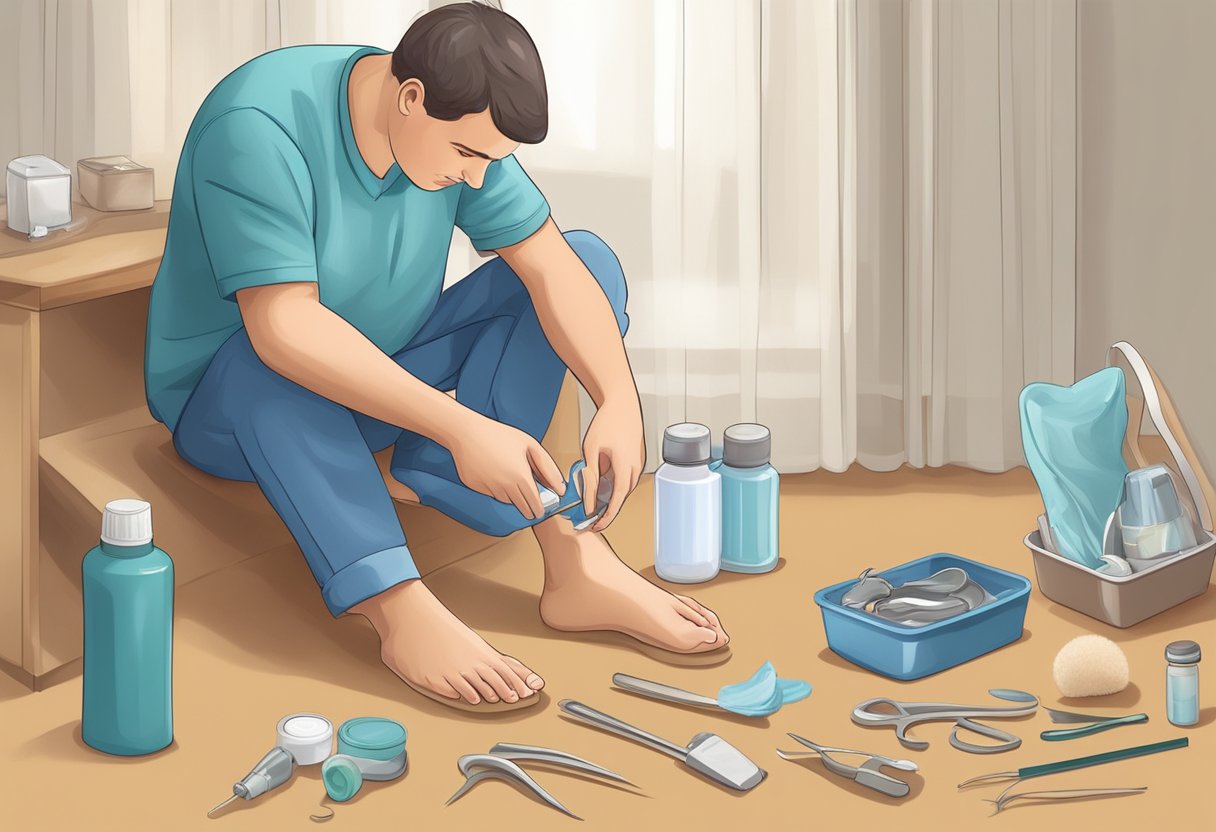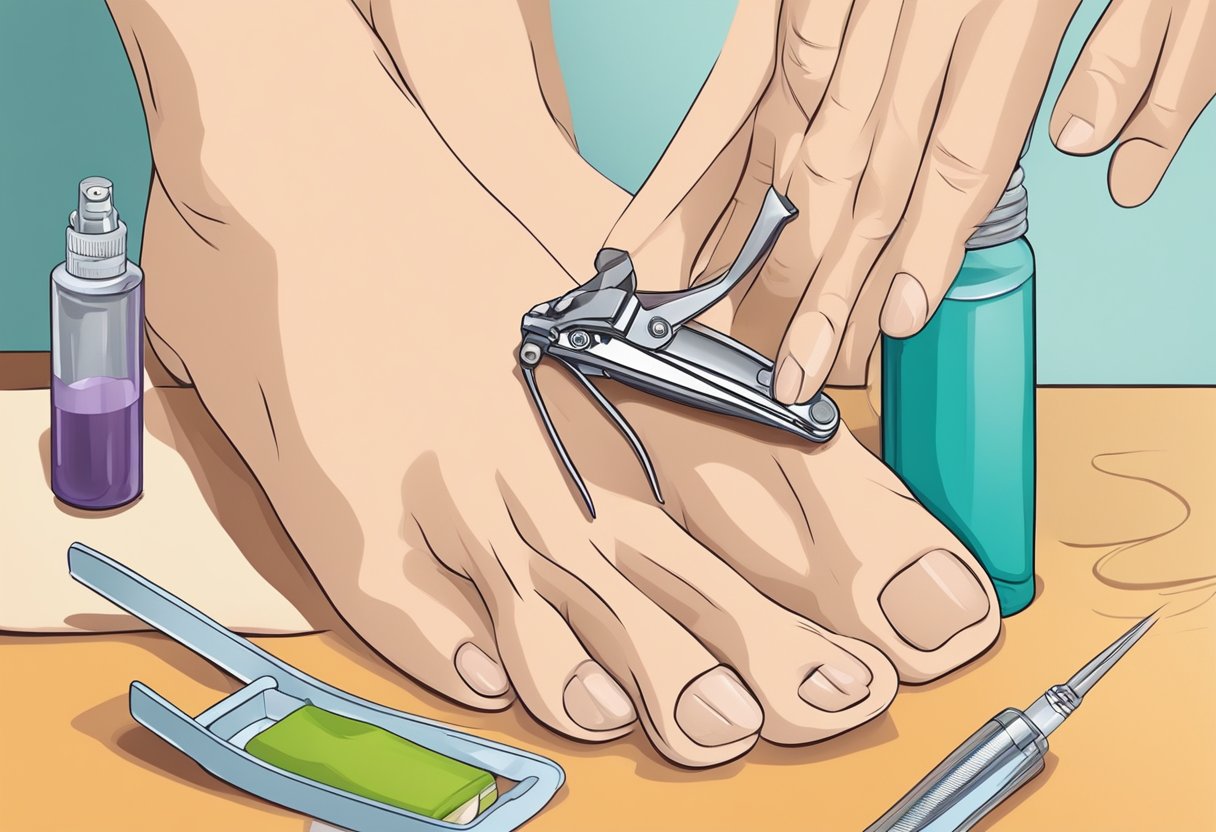Feet-Relief is supported by our audience. When you purchase through one of our links, we may earn a small affiliate commission. As an Amazon Associate I earn from qualifying purchases.Your cost is not affected.
When one of my sons had a major ingrown nail on his big toe, the doctor recommended surgery for a permanent fix. The procedure was done with anesthetic but recovery care took time. Fortunately, it is usually possible to treat ingrown toenails at home. I’ve researched effective remedies and also prevention tips to help others avoid this painful condition.
Treat Ingrown Toenails at Home: Effective Remedies and Prevention Tips
Ingrown toenails can cause significant discomfort and pain, often resulting from improper nail trimming, footwear that crowds the toes, or genetic predisposition. While this condition is common, many cases can be effectively managed at home without the need for professional medical treatment. Recognizing the early signs and symptoms, such as redness, swelling, and pain around the toenail, is crucial for timely and successful at-home care.
Effective home treatment for an ingrown toenail starts with proper identification and preparation. Soaking the affected foot can soften the nail and alleviate pain, making it easier to gently lift the ingrowing edge of the nail. Over-the-counter medication and simple remedies can also help reduce inflammation and discomfort as the toenail heals.
Key Takeaways
- Identifying symptoms early can lead to more successful at-home treatment.
- Soaking the foot and proper nail care are critical steps in managing ingrown toenails.
- Over-the-counter remedies can effectively reduce pain and inflammation.
Understanding Ingrown Toenails
https://www.youtube.com/watch?v=pD_kwiEjlO0&embed=true
An ingrown toenail occurs when the edge of your toenail grows into the surrounding skin. This condition commonly affects the big toe and can result in pain, redness, and swelling. If not treated properly, it might lead to infection.
Causes:
- Improper nail trimming: Cutting your toenails too short or not straight across may encourage the nail to grow into the skin.
- Tight footwear: Shoes that crowd your toenails can press the nail into the surrounding tissue.
- Injury: Stubbing your toe or other trauma can lead to an ingrown toenail.
Symptoms:
- Pain and tenderness along one or both sides of the nail
- Redness around the toenail
- Swelling of the toe around the nail
- Infection of the tissue around the toenail (if it’s infected)
Prevention Tips:
- Trim nails correctly: Straight across and not too short.
- Choose proper footwear: Wear shoes with a wide toe box.
- Protect your feet: Be cautious to avoid foot injuries.
Treating an ingrown toenail at home involves soaking your foot in warm water, wearing comfortable shoes, and carefully lifting the nail. For persistent or severe cases, consult a healthcare professional. Remember, proper foot hygiene and mindful nail care are your best defenses against ingrown toenails.
Identifying an Ingrown Toenail
Before attempting any treatment, it’s crucial for you to accurately identify an ingrown toenail. An incorrect assessment can delay proper care or exacerbate the issue.
Symptoms of Ingrown Toenails
Early recognition of ingrown toenails can save you from further pain and complications. Common symptoms include:
- Swelling around the nail
- Pain when pressure is applied
- Redness surrounding the toenail
- Infection of the tissue indicated by pus
If your toenail grows into the surrounding skin, causing red streaks or radiating pain, these are telltale signs that you may be dealing with an ingrown toenail.
Causes of Ingrown Toenails
Understanding what leads to ingrown toenails is essential for both prevention and treatment. The causes can include:
- Improper toenail trimming, such as cutting too short or not straight across
- Tight-fitting shoes that apply excessive pressure on the toenails
- An injury such as stubbing your toe which may alter the nail’s growth pattern
While factors like genetics can also play a role, the above causes are often the primary culprits behind an ingrown toenail.
Preparation for Treatment
Before attempting to treat your ingrown toenail at home, it’s important to determine whether self-care is appropriate and to ensure you have all the necessary tools on hand.
When to Seek Professional Care
You should consider professional medical treatment if you observe signs of infection, such as redness that spreads, increased pain, swelling, or pus. Untreated infections could lead to more serious complications, particularly if you have underlying health conditions like diabetes. Consulting a healthcare provider is crucial in these scenarios.
Gathering Necessary Tools
Home Treatment Methods
https://www.youtube.com/watch?v=Ie3hTsTr1yI&embed=true
Effective management of an ingrown toenail can alleviate discomfort and prevent infection. The following methods may assist in treating your ingrown toenail at home.
Soaking the Foot
Regularly soak your foot in warm water for about 15 to 20 minutes three to four times a day. This softens the skin around the ingrown toenail and can reduce swelling. Adding Epsom salt may help to further ease discomfort and soothe the affected area.
Lifting the Nail
After each soak, gently lifting the edge of the ingrown nail can encourage the nail to grow above the skin edge rather than into it. Use a piece of clean dental floss or a small cotton ball to carefully lift the nail. This is a temporary solution that can provide relief as the nail grows.
Applying Antibiotic Cream
To prevent infection, apply a thin layer of over-the-counter antibiotic cream or ointment to the tender area. Make sure to apply this cream after you’ve lifted the nail and before you bandage the toe, which can also help to keep the area clean.
Bandaging the Toe
After applying antibiotic cream, it’s important to cover the toe with a clean, dry bandage. This will protect the ingrown toenail and help to avoid further irritation from shoes or socks. Change the bandage daily to maintain cleanliness and assess the healing progress.
Pain Management
https://www.youtube.com/watch?v=TVALYjoSD0s&embed=true
Managing pain is crucial when treating an ingrown toenail at home. Proper pain management can help you stay comfortable as your toe heals.
Over-The-Counter Pain Relievers
You can take over-the-counter pain relievers such as acetaminophen or nonsteroidal anti-inflammatory drugs (NSAIDs) like ibuprofen to alleviate the pain associated with an ingrown toenail. Follow the dosage instructions on the label and be aware of potential side effects.
Home Remedies for Pain Relief
Applying a warm compress to the affected area several times a day can reduce swelling and discomfort. Soaking your foot in warm water mixed with Epsom salts can also help to soften the nail and soothe the pain. Some individuals find relief using apple cider vinegar due to its anti-inflammatory properties, but it should not replace medical treatment if the condition worsens.
Post-Treatment Care
https://www.youtube.com/watch?v=usnO_XnNkEo&embed=true
Successful management of an ingrown toenail doesn’t end with treatment. It’s crucial to protect the affected toe and monitor for signs of infection to ensure proper healing.
Protecting the Toe After Treatment
After treating an ingrown toenail, protecting the toe is essential. It’s advisable to:
- Wear comfortable shoes that provide ample space for the toes to prevent added pressure on the nail.
- Keep the toe clean by changing bandages regularly if you’ve been advised to keep it covered.
Monitoring for Infection
Infection can impede the healing process, so vigilance is key. You should:
- Look for redness, swelling, heat, or pain, which could be indicative of infection.
- Check for any discharge or foul smell, and seek medical attention promptly if these occur.
Prevention Strategies
In addressing ingrown toenails, prevention is essential. By maintaining proper foot hygiene, wearing appropriate footwear, and utilizing correct toenail trimming techniques, you can significantly reduce your risk of developing this painful condition.
Proper Foot Hygiene
Keeping your feet clean and dry is fundamental to prevent ingrown toenails. Wash your feet daily with soap and water, and make sure to dry them thoroughly, especially between the toes, to prevent moisture buildup that can facilitate infections.
Appropriate Footwear
Wearing shoes that fit properly is crucial. Ensure that your shoes have enough room to not squeeze or press on your nails. Consider options with a wide toe box that prevents crowding of the toes. If your shoes are too tight, the pressure can cause the nail to grow into the skin.
Toenail Trimming Techniques
Trim your toenails straight across and avoid cutting them too short. This Cleveland Clinic guide suggests that leaving the nails a little longer at the corners can help prevent the skin from folding over them, which often leads to ingrown toenails. Be careful not to round the corners of the nail, as this can also encourage the nail to grow into the surrounding skin.
Frequently Asked Questions
https://www.youtube.com/watch?v=8nEjRE5JFpE&embed=true
This section addresses common concerns about home treatment for ingrown toenails, including self-care techniques, home remedies, and pain management strategies.
What are effective methods for ingrown toenail self-care?
Self-care for ingrown toenails starts with proper foot hygiene and wearing shoes that fit correctly to avoid excessive pressure on the toes. Soaking the affected foot in warm water with Epsom salt can soften the skin and nail, which may alleviate some discomfort.
Can you describe a process for safe ingrown toenail removal at home?
For safe at-home ingrown toenail removal, first, soak your foot to soften the nail. Then, gently lift the ingrown edge and place a small piece of clean cotton or dental floss under it to encourage the nail to grow above the skin edge. Be careful not to cut the nail or dig into the skin.
What remedies can help dissolve an ingrown toenail?
Remedies that claim to dissolve an ingrown toenail are not typically recommended or effective, as the condition involves the nail physically growing into the skin. Treatment should focus on relieving symptoms and correcting the nail’s growth pattern.
Which medications are recommended for treating an ingrown toenail?
Over-the-counter pain relievers such as ibuprofen or acetaminophen can help manage the pain associated with ingrown toenails. If an infection is present, a healthcare provider may prescribe antibiotics to clear the infection.
Is it possible to fix an ingrown toenail permanently without surgery?
In many cases, persistent care and proper nail trimming can resolve an ingrown toenail without the need for surgery. However, if ingrown toenails are recurrent or severe, a permanent solution may require minor surgical intervention by a professional.
How can an ingrown toenail be numbed at home for painless removal?
While complete painless removal at home isn’t guaranteed, over-the-counter topical anesthetics containing lidocaine may provide temporary numbness to the area. However, it’s essential to proceed with caution and consider professional assistance for toenail removal.
Related Reading
Amazon and the Amazon logo are trademarks of Amazon.com, Inc, or its affiliates.







